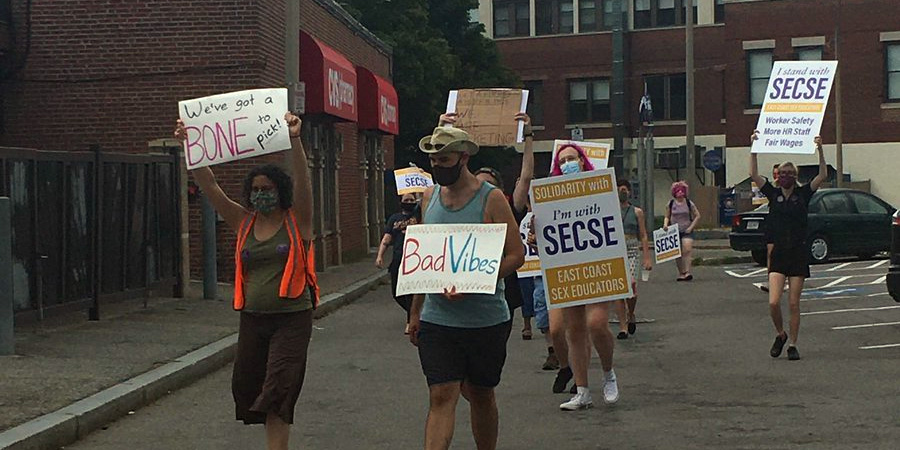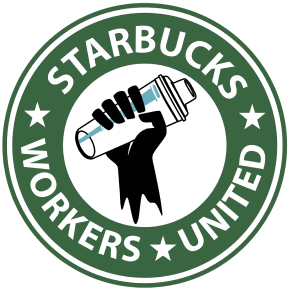
In August 2020, employees of sex toy retailer and education center Good Vibrations in Boston successfully completed a six-week strike. This was in response to a lack of COVID-19–related safety practices in their store from company management. This is the story of how their strike came into existence and how solidarity among co-workers and perseverance led them to success in their movement.
We started the year with a team of around 12 employees, most of whom (including myself) had been at Good Vibrations for more than two years. If you were to ask our customers and dig through our East Coast locations’ Yelp pages, you would only scratch the surface of seeing how talented and dedicated our unit was.
Knowledgeable Workers
We had a wide range of intersectional identities gathered around this cause of providing free education and quality, yet empathic, consultation on sexual health and wellness products. Folks went above and beyond in our stores, coming up with dozens of original workshop concepts and exploring everything from community-sourced, trans-specific sex education, to how different star signs might interact sexually. Our unique experiences brought the safe to the space. If you were trans, disabled, or struggling with mental illness, we had folks who were not only trained, but experienced, in navigating these nuances.
When communication within the workplace power dynamic became strained, well before the emergence of COVID-19 in the United States, we put into action the camaraderie we had as marginalized workers.
Collective Action
We began with discussing our concerns as a collective rather than as individuals who management encouraged to remain alienated from one another. As it became obvious that issues with morale were both mutual and unaddressed as a whole, the question of collective action dug its roots into our minds. COVID-19 dissipated our co-workers’ whispers about unionization as we scrambled to ensure our safety and secure unemployment.
When the dust settled somewhat and our recall process began, communication issues reached a boiling point. Learning about our recall via social media, receiving conflicting information about the process, and being wholly unsure about what kind of workplace we would be walking into left us missing around half of our staff.
On August 15, following the sudden resignation of one of our assistant managers, 100 percent of the remaining staff of Good Vibrations Cambridge and Brookline refused to come to work and sent a list of five demands to management.
Our name was Solidarity with East Coast Sex Educators (SECSE). (We are nothing without dumb sex-ed jokes.) With the support of numerous recent and not-so-recently former employees, we walked out with little to no experience beyond what we had researched in preparation. Over the next five days, amidst silence from the company, we reached out to a number of local labor organizations who advised us on our next steps.
Going Public
Initial negotiations didn’t yield answers to our demands. On August 20, we publicly announced the strike, taking to social media with tremendous force. Eva sculpted our social media image, and we worked together to create a petition and a strike fund, not knowing how long our strike would have to go on. Within days, we reached 2,000 signatures on our petition, and the fund exploded in our local community. Even the organizations we were working with, including the Emergency Workplace Organizing Committee (EWOC) and the Democratic Socialists of America (DSA), hadn’t predicted that, with such a small striking force, we could gather that much support so quickly.
I can attribute the overwhelming support of our wildcat strike to the interconnected solidarity within Boston’s queer community. Word spread fast, and, to this day, strangers will come into the store, asking us how the strike went.
As the company tried to get to the bottom of how this happened, what we were asking for, and why, management forced us to assume the worst about our positions at Good Vibrations. We knew picketing was necessary as negotiations continued to result in more questions than answers.
Good Vibrations on the Picket Line
Our first picket line was on August 22, and the store closed in anticipation of our action. Dozens of people turned out from EWOC, DSA, Pride at Work, and the Industrial Workers of the World (IWW) to support us. Outside of the Brookline location, we gathered, chanted, and spoke to the public in an action the size of which I never could have predicted.
Despite the success of this picket, we continued to hear very little in response from the company beyond rejections and requests for compromise. When our requests for more HR staffing were denied, we began communicating with union representatives in order to bring an alternative to the company in terms of workplace representation. This proved to be more of a wrench in the gears of the process than anything. The new suggestions resulted in further explanation, deliberation, and consideration from the company which lengthened negotiations further.
Over the course of the next few weeks, workers began to leave the strike and the company altogether to try and secure other jobs amidst the pandemic.
Struggle on the Line
Management made no promises that there would be a safe job for us to come back to, that they would make any changes, or that they wouldn’t just replace us with strikebreakers before then. Picketing escalated to daily shifts where three of the four remaining strikers would trade throughout the eight-hour work day to ensure that customers and scabs knew about our action.
This was a long and painful stretch of the strike that came to a head on September 4 when management called the police on our picket line. At the time, only three people were picketing. When the police arrived, they told the strikers that their actions were lawful before leaving soon after. Given how long we’d been out there and how vulnerable we had become, being only trans folks remaining, our noise reached its loudest for the next few weeks.
A Break in the Tension
It wasn’t until September 27, six weeks after the day we walked out of work, that management and the three final remaining workers reached an agreement. We won our first demand, which was to remove floor models of products from the shelves, which we would presented on request only.
We received new regional management, who promised raises and check-ins, and agreed to engage in mediated discussion with management to hopefully mend the trust that they had decimated through the lengthy strike process.
On September 30, amidst mediation with a mutually agreed-upon third party, two of the remaining three workers returned to work at the Cambridge location in good faith that mediation would help with the tension.
The Future of Good Vibrations
As of right now, my co-worker Fonda and I are the only two remaining workers who went on strike. All the rest left before, amidst, or at the end of the strike. We have yet to see how many of these changes will play out or if mediation will have a lasting effect on all parties, but, as cases are rising once again in Massachusetts with Cambridge becoming a COVID-19 yellow zone, we can only hope that we’ll be ready if we face a second wave.
Despite my sorrow for the peer relationships that I’ve lost through this process, the success of our strike couldn’t have happened without them. I thank every former worker of Good Vibrations for making this place what it is and inspiring me to continue on here. Organizing isn’t easy, but we won. Solidarity and the workers’ struggle will live on forever at Good Vibrations in the minds of those who experienced SECSE’s strike in any way.
Aria Carpenter is an employee of Good Vibrations and an organizer with Solidarity with East Coast Sex Educators (SECSE).




